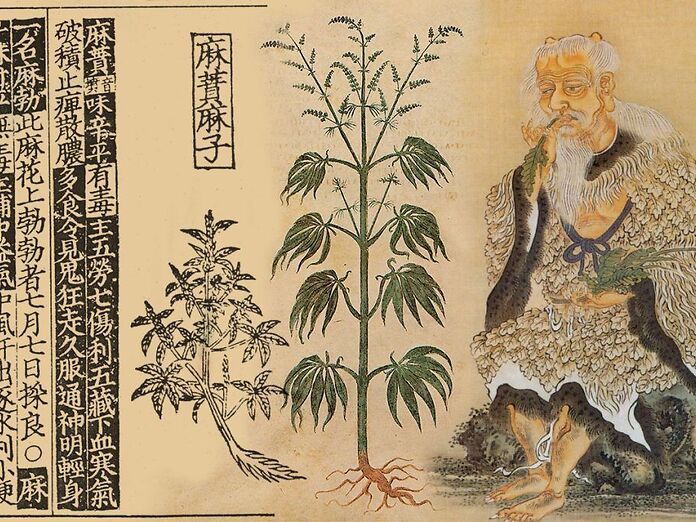Cannabis is one of the oldest plants used by mankind for various purposes, including medicinal, textile, and ritual. Ancient texts and treatises document the use of the plant in various cultures, from Eastern to Western civilizations. This article will explore the use of cannabis through ancient treatises, focusing primarily on documents from ancient China, India, and the Middle East, where the plant was used not only for medicinal purposes, but also for its ability to influence the mind and body.
Cannabis in Traditional Chinese Medicine: The “Shennong Bencaojing”
One of the oldest texts that references the use of cannabis is the Shennong Bencaojing (神农本草经), a Chinese herbal treatise dating back to 2000–3000 BC. Attributed to Shennong, the legendary emperor and father of Chinese medicine, the text is a compilation of knowledge about the medicinal properties of plants, including cannabis.
The Shennong Bencaojing classifies cannabis as one of the “superior plants,” meaning those that not only cure disease, but also promote longevity and well-being. The plant was primarily used in the form of seeds, known as “ma zi” (麻子), which were believed to have therapeutic effects on the body. In particular, cannabis seeds were prescribed to treat digestive disorders, such as constipation, and inflammatory diseases. According to the treatise, continued use of cannabis seeds could “enlighten the spirit” and improve overall health.
Medical and Spiritual Use
In addition to medicinal use, the Shennong Bencaojing also recognized some psychoactive properties of the plant. In particular, reference was made to the use of the leaves and flowers to alter the mental state and induce a state of calm or deep relaxation. However, excessive use of these components was discouraged, as it could lead to “demonic visions”, a description that probably reflected an intense psychoactive effect. This use of cannabis for spiritual purposes was also linked to shamanic rituals, practices common in the tribal cultures of Northern China and Mongolia.
Cannabis in Indian Sacred Texts: The Atharvaveda
In Indian tradition, cannabis appears in the Atharvaveda, an ancient Sanskrit text that is part of the four Vedas, the oldest and most sacred texts of Hinduism, dating back to around 1500 BCE. The Atharvaveda refers to cannabis as one of the “five sacred plants” and describes it as an herb that can ward off evil and promote well-being. The plant was called bhang or vijaya, terms that indicate its ability to create a state of mental well-being.
According to the Atharvaveda, cannabis was used in religious ceremonies and rituals to communicate with deities and obtain divine visions. Its calming properties were valued for the ability to induce a state of deep meditation and detachment from worldly concerns. In addition to spiritual use, Indian texts also mentioned the medical use of cannabis, particularly as an analgesic and anti-inflammatory.
Ayurvedic Treatises
In Ayurvedic medicine, which dates back thousands of years, cannabis has been used to treat a wide range of ailments. Ancient Ayurvedic texts, such as the Sushruta Samhita and the Charaka Samhita, describe the use of the plant to treat epilepsy, chronic pain, and respiratory diseases. Ancient Ayurvedic healers prepared decoctions and infusions of cannabis mixed with other herbs to achieve specific therapeutic effects.
Cannabis in the Ancient Middle East: The Ebers Papyrus
Another important historical document that refers to cannabis is the Ebers Papyrus, one of the oldest known medical texts, dating back to ancient Egypt in 1550 BC. This treatise is a collection of over 700 medical remedies and prescriptions, many of which involve the use of herbs. Although the papyrus does not explicitly mention cannabis by the name we use today, it does refer to a plant called “shemshemet”, which some scholars identify with cannabis.
In the Ebers Papyrus, the plant was used in medical preparations applied topically to relieve pain and inflammation. It was also used as a remedy to treat ear infections and other ailments. The use of cannabis in Egypt was not limited to medicine: some archaeological finds indicate that the plant may also have been used in funeral ceremonies and religious rituals.
Cannabis in Dioscorides’ De Materia Medica
In ancient Greece and Rome, cannabis was known through the work of the Greek physician Pedanius Dioscorides, whose treatise De Materia Medica (50–70 AD) became one of the most influential medical texts of antiquity and the Middle Ages. In this treatise, Dioscorides described the cannabis plant, called “kannabis,” and its therapeutic applications. He noted that the leaves of the plant could be used to relieve pain and treat wounds, while the seeds were used as a remedy for gastrointestinal disorders.
Dioscorides’ work was widely disseminated and translated into several languages, and his descriptions of cannabis influenced Arabic and later European medicine. Medieval physicians used the information provided by Dioscorides to incorporate cannabis into their therapeutic practices, especially for the treatment of rheumatic pain and inflammation.
Cannabis has a long history of use documented in many ancient medical treatises and texts. From the Chinese texts of the Shennong Bencaojing to the sacred Indian Vedas to Greek and Roman writings, the plant has been valued for its many properties, both therapeutic and spiritual. These treatises demonstrate that cannabis was a versatile plant, used to treat physical ailments, induce states of meditation, and connect humans to the spiritual world. Its constant presence in ancient medicine and rituals indicates that cannabis has been one of the most important herbs in human history, a wealth of knowledge that continues to influence modern scientific and medical research.




